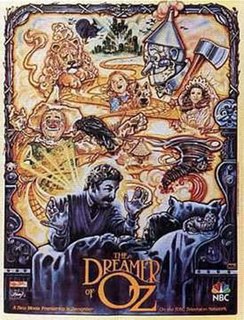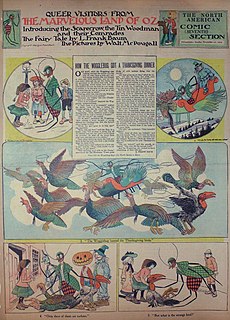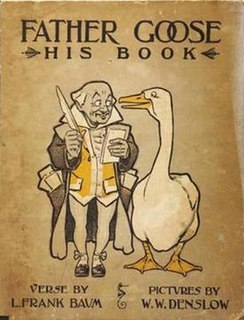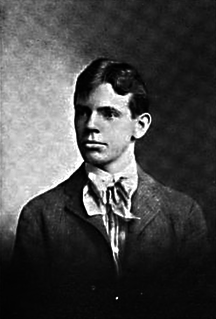Related Research Articles

Lyman Frank Baum was an American author best known for his children's books, particularly The Wonderful Wizard of Oz and its sequels. He wrote 14 novels in the Oz series, plus 41 other novels, 83 short stories, over 200 poems, and at least 42 scripts. He made numerous attempts to bring his works to the stage and screen; the 1939 adaptation of the first Oz book became a landmark of 20th-century cinema.

The Wonderful Wizard of Oz is an American children's novel written by author L. Frank Baum and illustrated by W.W. Denslow, originally published by the George M. Hill Company in May 1900. It has since seen several reprints, most often under the title The Wizard of Oz, which is the title of the popular 1902 Broadway musical adaptation as well as the iconic 1939 live-action film.
John Dickson Carr was an American author of detective stories, who also published using the pseudonyms Carter Dickson, Carr Dickson, and Roger Fairbairn.

William Anthony Parker White known by his pen-name Anthony Boucher, was an American author, critic, and editor, who wrote several classic mystery novels, short stories, science fiction, and radio dramas. Between 1942 and 1947 he acted as reviewer of mostly mystery fiction for the San Francisco Chronicle. In addition to "Anthony Boucher", White also employed the pseudonym "H. H. Holmes", which was the pseudonym of a late-19th-century American serial killer; Boucher would also write light verse and sign it "Herman W. Mudgett".

Ruth Plumly Thompson was an American writer of children's stories, best known for writing many novels placed in Oz, the fictional land of L. Frank Baum's classic children's novel The Wonderful Wizard of Oz and its sequels.

John Rea Neill was a magazine and children's book illustrator primarily known for illustrating more than forty stories set in the Land of Oz, including L. Frank Baum's, Ruth Plumly Thompson's, and three of his own. His pen-and-ink drawings have become identified almost exclusively with the Oz series. He did a great deal of magazine and newspaper illustration work which is not as well known today.

William Wallace Denslow, professionally W. W. Denslow, was an American illustrator and caricaturist remembered for his work in collaboration with author L. Frank Baum, especially his illustrations of The Wonderful Wizard of Oz. Denslow was an editorial cartoonist with a strong interest in politics, which has fueled political interpretations of The Wonderful Wizard of Oz.
Edward Dentinger Hoch was an American writer of detective fiction. Although he wrote several novels, he was primarily known for his vast output of over 950 short stories.

The Dreamer of Oz: The L. Frank Baum Story is a 1990 American made-for-television biographical film starring John Ritter as Lyman Frank Baum, the author who wrote the 1900 novel The Wonderful Wizard of Oz and thirteen other Oz books. Also starring in it was Annette O'Toole as Baum's supportive wife, Maud, and Rue McClanahan as Baum's tough mother-in-law, Matilda Gage. John's son, Jason Ritter, makes his debut in it as Harry Neal Baum. At the time of its debut, O'Toole and Ritter also starred in It, a TV miniseries where they played a couple.

Richard Allen Lupoff was an American science-fiction and mystery author, who also wrote humor, satire, nonfiction and reviews. In addition to his two dozen novels and more than 40 short stories, he also edited science-fantasy anthologies. He was an expert on the writing of Edgar Rice Burroughs, and had an equally strong interest in H. P. Lovecraft.
John Frederick "Jack" Snow, born Piqua, Ohio was an American radio writer, writer of ghost stories, and scholar, primarily of the works of L. Frank Baum. When Baum died in 1919, the twelve-year-old Snow offered to be the next Royal Historian of Oz, but was politely turned down by a staffer at Baum's publisher, Reilly & Lee. Snow eventually wrote two Oz books: The Magical Mimics in Oz (1946) and The Shaggy Man of Oz (1949), as well as Who's Who in Oz (1954), a thorough guide to the Oz characters, all of which Reilly & Lee published.
Michael Patrick Hearn is an American literary scholar as well as a man of letters specializing in children's literature and its illustration. His works include The Annotated Wizard of Oz (1973/2000), The Annotated Christmas Carol (1977/2003), and The Annotated Huckleberry Finn (2001). He considers the three most quintessential American novels to be Moby-Dick by Herman Melville, The Wonderful Wizard of Oz by L. Frank Baum, and The Adventures of Huckleberry Finn by Mark Twain.

Queer Visitors from the Marvelous Land of Oz was a newspaper comic strip written by L. Frank Baum and illustrated by Walt McDougall, a political cartoonist for the Philadelphia North American. Queer Visitors appeared in the North American, the Chicago Record-Herald and other newspapers from 28 August 1904 to 26 February 1905. The series chronicles the misadventures of the Scarecrow, the Tin Woodman, the Woggle-Bug, Jack Pumpkinhead, and the Sawhorse, as the Gump flies them to various cities in the United States. The comic strip in turn produced its own derivation, The Woggle-Bug Book (1905).

Father Goose: His Book is a collection of nonsense poetry for children, written by L. Frank Baum and illustrated by W. W. Denslow, and first published in 1899. Though generally neglected a century later, the book was a groundbreaking sensation in its own era; "once America's best-selling children's book and L. Frank Baum's first success," Father Goose laid a foundation for the writing career that soon led to The Wonderful Wizard of Oz and all of Baum's later work.

L. Frank Baum's Juvenile Speaker: Readings and Recitations in Prose and Verse, Humorous and Otherwise is an anthology of literary works by L. Frank Baum, author of the Oz books. The book was first published in 1910, with illustrations by veteran Baum artists John R. Neill and Maginel Wright Enright; a subsequent 1912 edition was retitled Baum's Own Book for Children. The book constitutes a complex element in the Baum bibliography.

Little Wizard Stories of Oz is a set of six short stories written for young children by L. Frank Baum, the creator of the Oz books. The six tales were published in separate small booklets, "Oz books in miniature," in 1913, and then in a collected edition in 1914 with illustrations by John R. Neill. Each booklet is 29 pages long, and printed in blue ink rather than black.

Harry Neal Baum was an American author and the third son of L. Frank Baum. His father dedicated his 1902 novel The Life and Adventures of Santa Claus to him.
Jeffrey Marks is an American author.

Isaac "Ike" Morgan was a well-known newspaper illustrator for several big newspapers in Chicago and New York.
Crippen & Landru Publishers is a small publisher of mystery fiction collections, based in Cincinnati, Ohio, United States. It was founded in 1994 by husband and wife Sandi and Douglas G. Greene in Norfolk, Virginia, United States, and is named after murderers Dr. H. H. Crippen and Henri Landru. The Greenes's son Eric designed the logo. Jeffrey Marks succeeded Douglas G. Greene as publisher on January 1, 2018, while Dr. Greene remained active as Series Editor.
References
- ↑ Terry, Mark. "Crippen & Landru Raising the Bar". Mystery Scene Mag. Retrieved 5 September 2015.
- ↑ "David L. Greene and Douglas G. Greene". The International Wizard of Oz Club. Retrieved 4 September 2015.
- ↑ "Detective Fiction Community Honors Greene with New Book". Old Dominion University. Retrieved 4 September 2015.
- ↑ "ODU PROFESSOR GREENE, "SISTERS IN CRIME" RECEIVE GEORGE N. DOVE AWARD". Old Dominion University. Retrieved 4 September 2015.
- ↑ "Mysteries Unlocked: Essays in Honor of Douglas G. Greene". Mystery Scene. Retrieved 4 September 2015.
- ↑ "Search the Edgars Database!". Mystery Writers of America. Retrieved 4 September 2015.